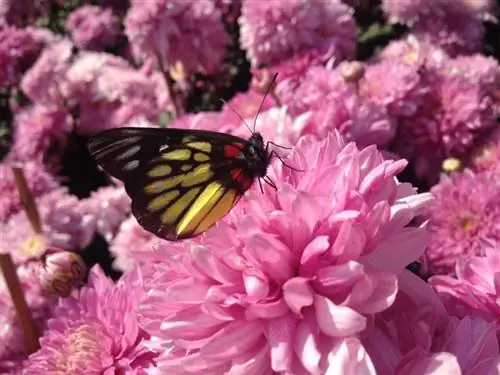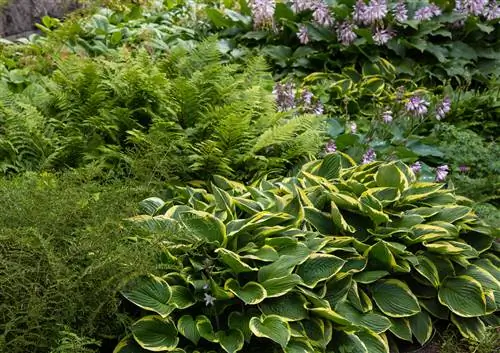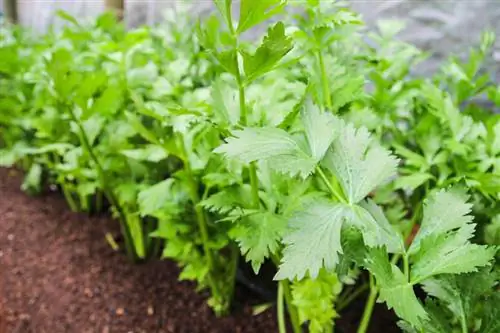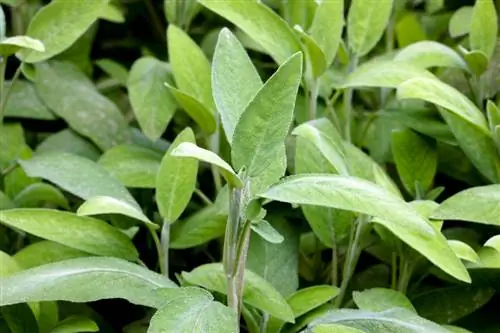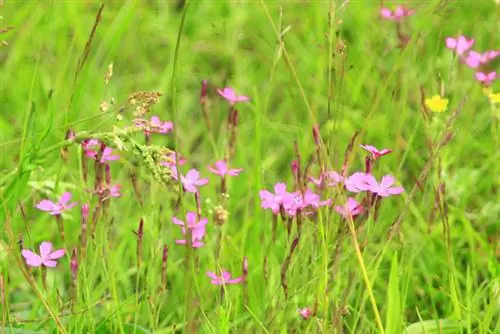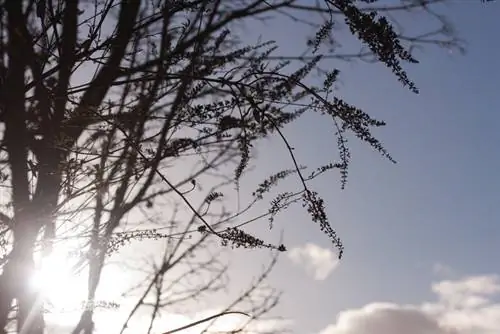- Author admin [email protected].
- Public 2023-12-25 17:45.
- Last modified 2025-01-23 11:22.
Chrysanthemums start their furious flower festival when other perennials have already exhausted themselves. The diverse genre leaves no design wishes unfulfilled for beds and pots. If you still have questions about the correct cultivation of the popular flower, you will receive a solid answer here.
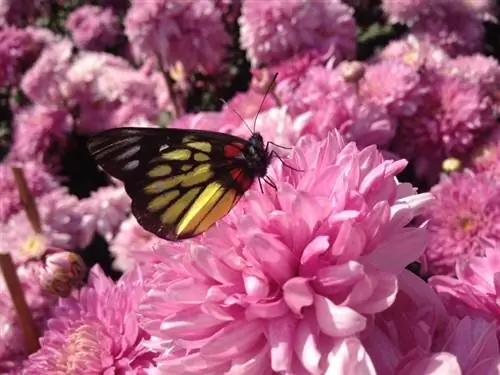
How do I care for chrysanthemums properly?
Chrysanthemums require regular watering, organic or mineral-organic fertilizer every two weeks, the removal of wilted flowers, a sunny to partially shaded location, nutrient-rich and humus-rich soil and protective measures for winter-hardy varieties during the cold months.
Planting chrysanthemums correctly
In order to plant a chrysanthemum correctly, only a few aspects are relevant. Follow these steps:
- Put the potted young plant in water for 10-20 minutes
- Make a pit in the loosened, weeded soil with twice the volume of the root ball
- Optimize the excavated soil with compost and horn shavings
- Unpot the flower and plant it up to the root collar
- Tie tall growing varieties to a support pole
Press the soil firmly with your hands and water with a good sip of water. Finally, spread a layer of mulch with fern leaves, leaves, grass clippings, bark mulch or nettles. In the pot, use a compost-based potting soil as a substrate and spread a drainage system made of pottery shards over the water drain.read more
Care tips
The cornerstones of professional care include a balanced water and nutrient balance, the right cut and careful winter storage. All important details at a glance:
- Water the flower as soon as the substrate has dried
- Fertilize organically every 14 days from May to September or apply a slow-release fertilizer (€9.00 on Amazon) in May and July
- From a height of 50 cm, shorten by half once to optimize stability
- Clean up wilted flowers regularly
- Do not prune the ground-level leaves until late winter
Winter-hardy chrysanthemum species and varieties are piled up with leaves, straw or coniferous twigs after the autumn blossoms. Spread jute cloths or a felt hood over bushes. Put potted plants in their frost-free winter quarters. Do not allow the plants to dry out or apply fertilizer during the winter.
Which location is suitable?
The species-rich flower prefers a sunny to partially shaded location, without summer heat. The higher the chrysanthemum grows, the more protected from the wind the location should be. Cultivated as a houseplant, the flower adorns a winter windowsill in a sunny spot at temperatures of 15-18 degrees Celsius.read more
The correct planting distance
A general measurement for the perfect planting distance is not possible given the wide variety of species and varieties. To determine the appropriate distance to the plant neighbor, take a look at the expected growth height and divide this value by 2.
What soil does the plant need?
So that chrysanthemums can stage their flower spectacle, they should be provided with the following soil conditions:
- Nutritional and humic
- Fresh, moist and without the risk of waterlogging
- Sandy-loamy, permeable
If in doubt, prepare the soil with simple soil additives so that the flower feels comfortable. Sandy soil can be optimized with mature compost, while heavy soil can be improved with sand.
What is the best time to plant?
The best time to plant chrysanthemums is spring and early summer to mid/late June. At this time you give the flower enough time to establish itself well in the substrate and survive the following winter in good he alth. Specimens grown in containers can also be planted in the ground in autumn, as long as they are a hardy variety.
When is flowering time?
The flowering period begins in August/September when the days become shorter. Depending on the species and variety chosen, the flowering extends over the months of September and October and into November. Half-height chrysanthemums bloom as houseplants throughout the winter in a bright window seat at 15-16 degrees Celsius.
Cut chrysanthemums correctly
If you regularly cut out wilted flowers, this measure will help extend the flowering period. Once a chrysanthemum bush has reached a height of 50 centimeters for the first time, cut all shoots back by half. This trick improves stability without affecting flowering. However, you only carry out the pruning close to the ground in late winter so that the leaves can protect the plant from frost and cold moisture.read more
Watering chrysanthemums
Water the flower regularly and thoroughly without causing waterlogging. You can water a dense chrysanthemum bush even after a rain shower, as raindrops do not reach the ground. If the flower lets its leaves hang limply, it should be watered immediately.read more
Fertilize chrysanthemums properly
The nutrient requirements of chrysanthemums are medium to high. From May to September, fertilize the flower with an organic or mineral-organic preparation every 14 days. Repeated mulching with compost is recommended. Fertilize winter-flowering houseplants until the end of the flowering period with a liquid fertilizer that you add to the irrigation water every second watering.
Diseases
The chrysanthemum is primarily susceptible to fungal infections. The two most important diseases at a glance:
- Mildew: fight the mealy-white fungal lawn with milk-water in a ratio of 1:9
- Chrysanthemum rust: if there are yellowish-green spots, remove diseased leaves and fight pathogens with a rapeseed oil preparation
When watering, be sure to avoid spraying the leaves and flowers. This prudence serves to effectively prevent illness.
Pests
Arm the chrysanthemum against the following pests:
- Leaf miner fly: collect the 3 mm small insects, cut off the affected leaves, fight with neem preparation
- Sheaf bugs: shake off the 5-10 mm large, winged pests in the early morning onto a support, fight with neem seeds
- Black weevil: take action against adult, black beetles and larvae with bait traps and nematodes
If the omnipresent aphids attack the flower, get rid of the pest with a soap solution made from 15 ml soft soap, 1 splash of spirit and 1 liter of water.
Wintering
Some chrysanthemum species and varieties have the potential to survive the winter in the bed. The pink-flowering winter aster 'Julchen' is one of them, as are the white-flowering varieties 'White Bouquet' and 'Poesie'. However, the plants cannot survive the cold season without any protective measures. How to do it right:
- Before the first frost, pile the flower thickly with leaves, straw, compost or pine needles
- Protect bushes additionally with newspaper, jute ribbons or garden fleece
- Leave the withered leaves on the plant until early spring and then cut them off
In a bucket or balcony box, chrysanthemums ideally move to a bright winter quarters where temperatures prevail between 5 and 10 degrees Celsius. Only water the flower enough so that the root ball does not dry out and stop adding fertilizer.read more
Propagate chrysanthemums
To propagate your most beautiful flower by variety, use the uncomplicated cutting method. In the period from May to June, cut 10-15 cm long, non-flowering head cuttings. This is how offspring are successfully bred:
- Make the cut just below one eye
- Leave the offshoot except for the upper pair of leaves
- Planting in small pots filled with potting soil
In a partially shaded, protected location, keep the substrate constantly moist. If the first shoots appear, the underground rooting is proceeding as desired. To speed up the process, put a transparent hood over the cutting, which is ventilated daily.read more
How do I transplant correctly?
Replanting the perennial every 3-5 years helps maintain its vitality and willingness to bloom. At the same time, this measure allows for uncomplicated propagation. In early spring, dig up the root ball and break it up with a spade. The less damage to the roots, the better for the flower. Plant the segments at the new or existing location without any further delay.
Chrysanthemums in a pot
In pots, chrysanthemums decorate balconies, terraces and house entrances. They also create eye-catching accents on the half-shaded windowsill. In order for the flowers to continue to grow for 20 to 40 days, this care is important:
- Keep the substrate constantly slightly moist
- During the growth and flowering period, fertilize liquidly every 14 days
- Cleaning up wilted flowers
- Only cut off the leaves close to the ground when they have completely dried up
When winter knocks on the garden door, potted chrysanthemums move to the bright, frost-free winter quarters. The risk of the root ball freezing is too great due to its exposed location. Water and fertilize winter-flowering varieties in a sunny location at temperatures not above 20 degrees Celsius.read more
Are chrysanthemums poisonous?
With regard to the toxic content of a chrysanthemum, people can be given the all-clear. However, the flower is life-threatening for pets, especially dogs and cats. Even small amounts of the flowers and leaves can cause the worst symptoms of poisoning. Therefore, do not include the ornamental plant in the planting plan if you want to protect your four-legged companions.read more
Chrysanthemums don't bloom
If the chrysanthemum you grew yourself simply doesn't want to bloom, it is receiving too much daylight. As a typical short-day plant, flowering induction is closely related to the duration of day and night. You can simulate the natural process to encourage the flower to bloom. To do this, take the plant into a dark room in the early evening or put an opaque cover over it. If the flower receives less than 10 hours of light per day over a period of 6 weeks, the longed-for flower bloom will develop.
Brown leaves
Brown leaves signal that the flower is not feeling well. If it is mostly older foliage, there is a lack of nutrients. Fertilize with a liquid fertilizer for flowering plants as this is absorbed more quickly. If all the leaves turn brown, the flower is suffering from drought stress. Water chrysanthemums regularly and thoroughly, even after a rain shower.
How do I make chrysanthemums bloom?
It is common practice in professional nurseries to control the flowering of chrysanthemums using a simple blackout trick. Since the flower is one of the short-day plants, it waits to bloom until the days become shorter. If you simulate this process, you will attract the flowers early. This is how the gardening trick works:
- Put a black bucket over the flower in the early evening
- Leave the cover in place so that the chrysanthemum is in the light for less than 10 hours
If you do this over a period of 6 weeks, the buds will open, regardless of the date on the calendar. The short-day simulation only works to your complete satisfaction if the flower is not caught by a single ray of light during the darkening.
Beautiful varieties
- Fire magic: magnificent garden chrysanthemum with purple-red, double flowers from August to October
- Havel swan: white blooming and bulging, the flower enchants from October to November; Growth height 80 cm
- Bees: impresses with deep yellow pompom flowers in late autumn; Growth height up to 90 cm
- Autumn ruby: majestic chrysanthemum with ruby-red, double flowers; Growth height 100-110 cm
- Mary Stoker: historical variety with simple bronze-yellow flowers and yellow heart; Growth height 60 cm

